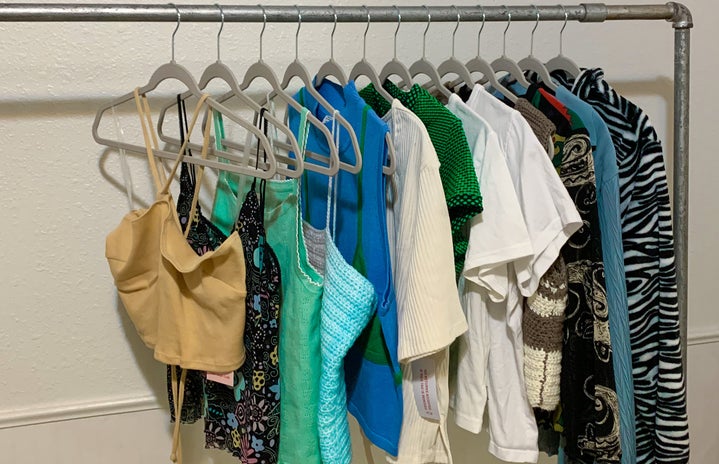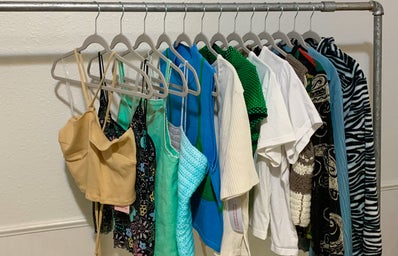Trends have almost always existed in the fashion world. Certain colors, fabrics, cuts, etc… become widely popular for periods of time. The 60s are characterized by baggy hippie clothing and mod styles. The 70s are known for high rise bell bottoms and shoes with platforms. The 80s brought about the leather and plaid punk trend as well as shoulder pads. The 90s were more subdued than the previous decades. These eras are all known by the fashion trends that arose during each time period.
The trend cycle
Fashion trends operate in a cycle. Past trends will resurface with slight variations. For example, brands such as Von Dutch and Fiorucci saw a revival in popularity as the “Y2K” aesthetic became immensely popular in the last year. Another popular item in this wave is the UGG boot. In the early 2000s when the trend experienced its first popularity spike, the boots were either mid-calf or almost to the knee, primarily being seen in the various brown/khaki/grey/black earthy classics. UGGs have become popular again in 2021, but they look slightly different this time. Now, the most popular UGGs are in the same slouchy sheepskin fabrics and colors, but the most popular styles are the UGG minis, which are only the height of an ankle boot. This serves as an example of the reemergence of the popularity of an item through the trend cycle.
social media and micro-trends
Traditionally, the trend cycle operated in a 20–30-year timeframe. However, this has changed, with most trends not even lasting a full year. Some claims point to most trends lasting only a week to three months. The use of social media is widespread, and its influence should not be underestimated. Influencers play a significant role in the trend cycle and the speed at which it operates. Social media allows trend setters to communicate their ideas and opinions to their following instantaneously, and online shopping allows those influenced individuals to purchase the latest trends immediately. While fashion magazines may take weeks to write and publish and then be consumed by mass audiences, fashion TikTokers now can decide that one item is cool, post a 30-second video about it, causing viewers to seek after it to participate in the new trend, and then abandon it for another in only a matter of weeks. The items and styles of this acceleration of the fashion trend cycle have become known as micro-trends.
One of the most notorious micro-trends is the Hockney dress from the brand House of Sunny. Traditionally being made up of a couple shades of green, the knit tank dress with spiral patterns and circular cut-outs on the back became THE dress of the summer in 2020. Every it-girl on the internet was posting in the dress, putting it in high demand. The $128 price point made it inaccessible to many coveting audience members, causing many fast fashion brands (which are known for unethical practices and being the opposite of eco-friendly), such as Shein and Amazon to produce dupes. This item was majorly trendy for a few months, but it did not last.
“Cheugy”
With the increased ease of spreading trends through social media it has become common for trends to become cancelled not long after their rises to popularity. The term “cheugy” became popular on TikTok to describe trends that have become outdated. It started with younger people calling skinny jeans and infinite scarves cheugy, but it quickly snowballed into people sharing ideas about how even last week’s trends had since become cheugy and therefore cringey to participate in. With this wave, it also became popular to refer to anything popular as a micro-trend and just completely annihilate anything that was not the absolute newest and greatest.
Negative effects
These occurrences brought about negative results. The popularity of calling things out as cheugy or “just a micro-trend” was a way of berating creators for not being trendy enough. This causes them to get rid of their clothing only to buy more that will also have an early expiration date, as participating in order trends or finding new ways to style older pieces is not what is trendy. This causes so much excess textile waste as estimations show that over 80% of clothing ends up in landfills or incinerators. Even much of the clothing donated to thrift stores has the same fate.
The environmental impact of micro-trends goes beyond this waste. With expensive trending items being inaccessible for many people, fast fashion companies are presented with an opportunity. These companies manufacture similar, sometimes identical, items of cheaper quality for a lower price so that more people can participate in a trend. These companies are known for taking advantage of poor working conditions (sometimes using child labor), using unsustainable fabrics, and producing items that are not made to last.
personal style
The popularization of micro-trends and the use of the term as well as the word cheugy have had other negative impacts. For example, shaming or calling people out for the way they dress. Sure, there may be instances where an individual is looking for fashion advice or help from their audience, but most often, people wear things they like and are berated for it. This behavior kills personal style, as it stresses the value of conformity over originality. People’s personal style goes beyond trends. Often it is characterized by a collection of unique pieces that are not all currently trending and styled in nontraditional ways. Personal style can also look like a serious commitment to a past trend cycle, with an individual looking like they walked out of a different decade. Personal style can also be anything in between.
Recently, some TikTok creators with unique personal styles have seen success and positive reception. Previously, it was common for these individuals’ comment sections to be flooded with people insisting that their outfits must be satirical or that they must be playing a character. More recently, however, the tides have turned in their favor, with increased viewers appreciating the individuality of these creators’ personal styles. Examples of such creators are @tinyjewishgirl, @annagolkayepez, @myramagdalen, and @saracampz. Another creator who shares their own personal style is @oldloserinbrooklyn, who also makes content commenting on trends and personal styles.
2022 Resolution
My hope for myself and others in 2022 is that we abandon shaming people for their personal style. Who cares if someone is committed to an old trend? At least they know what they like! I also challenge myself and those reading to experiment with their own style. Maybe try styling the clothes you no longer wear in new ways that excite you. Try to dress for yourself, wearing what makes you feel confident and most like yourself, rather than dressing for others or following trends just to fit in.


